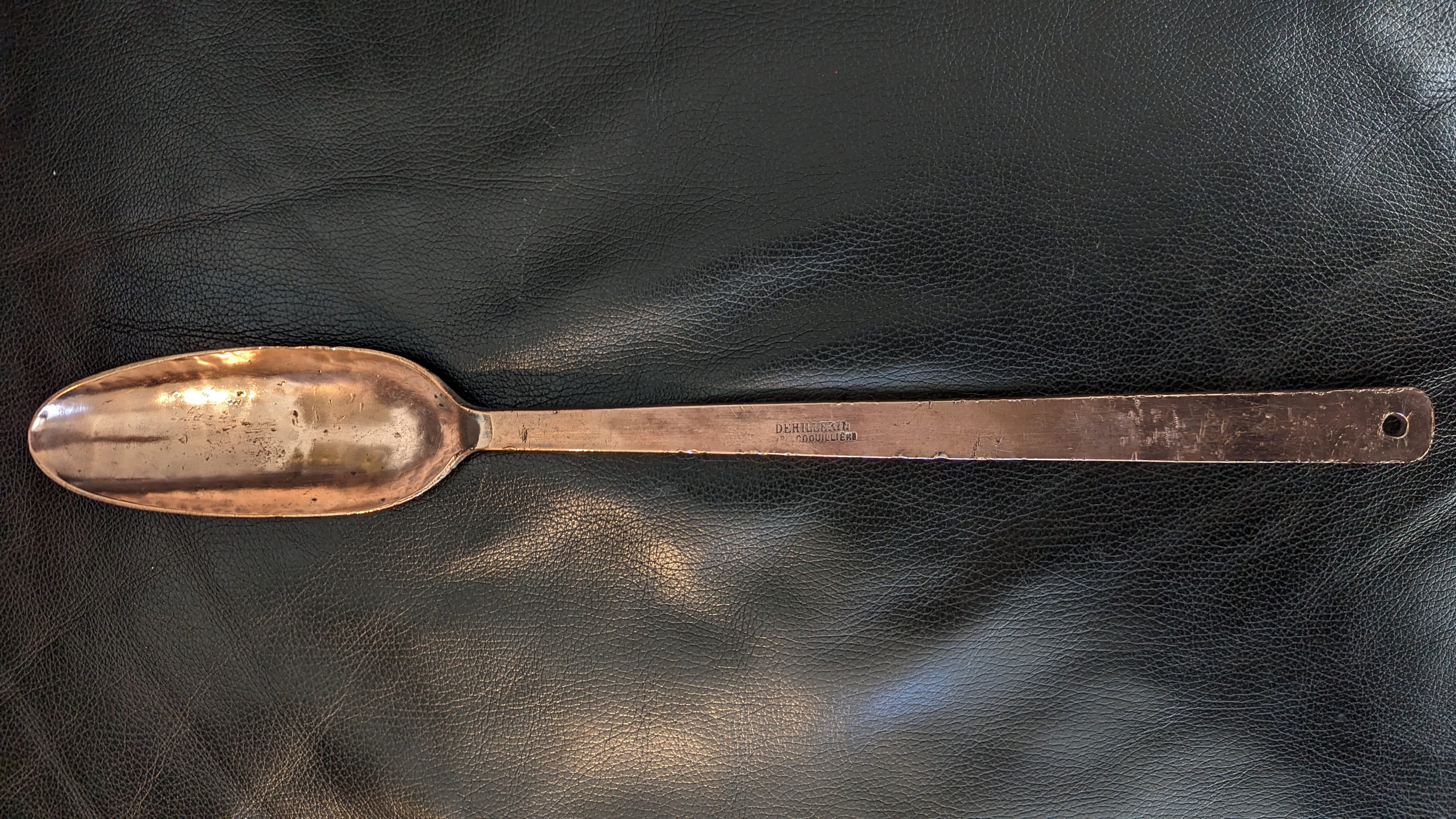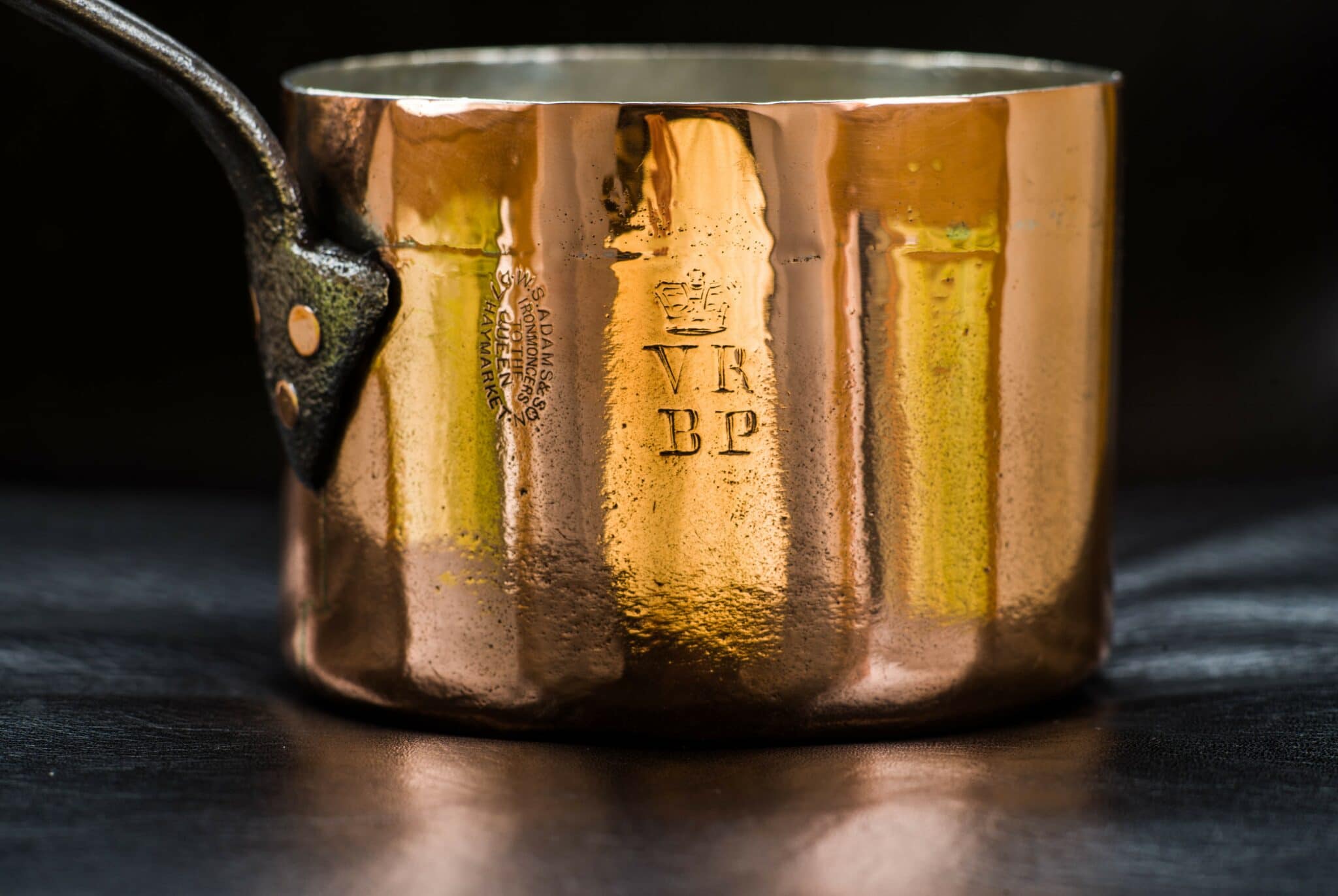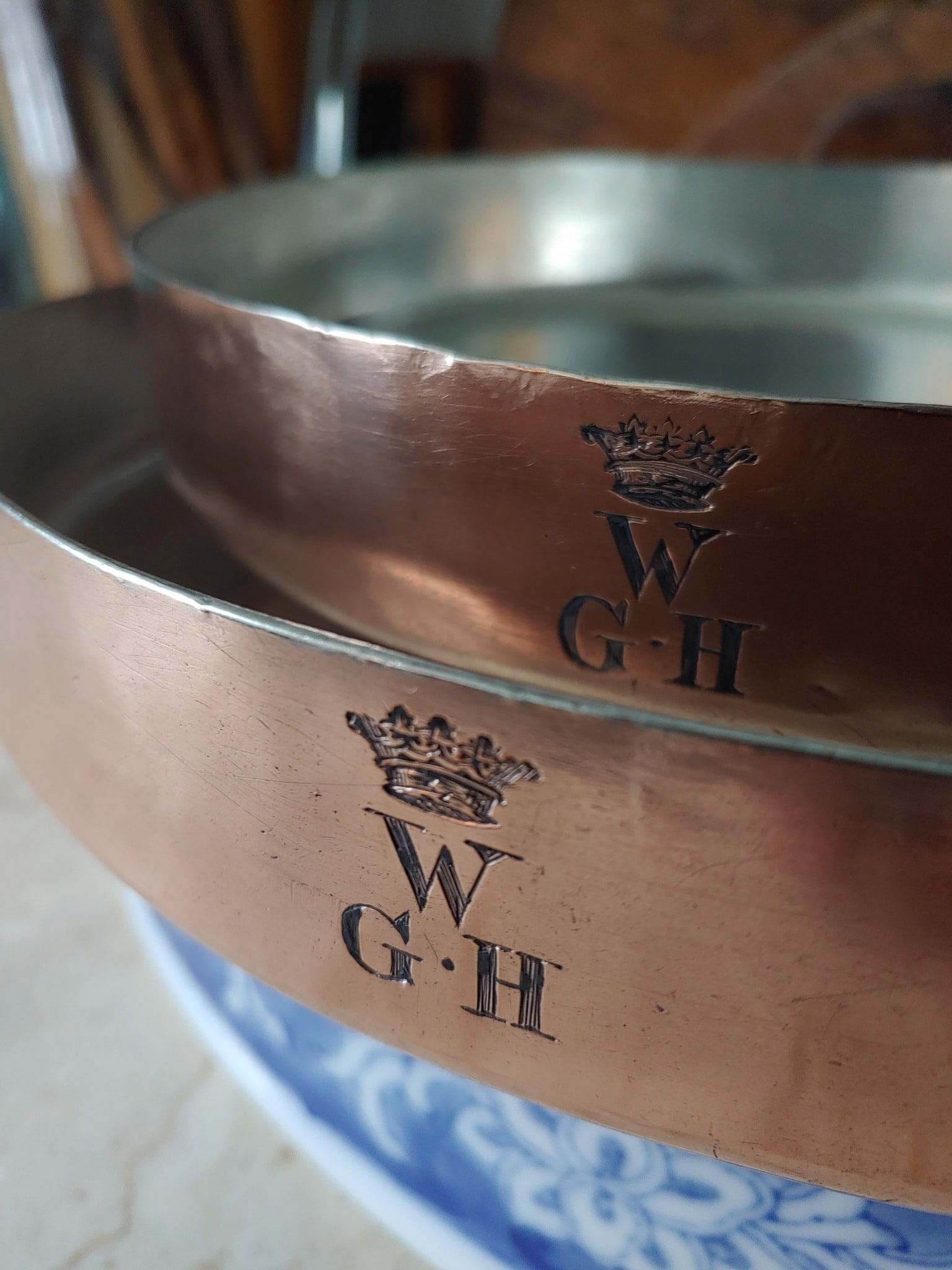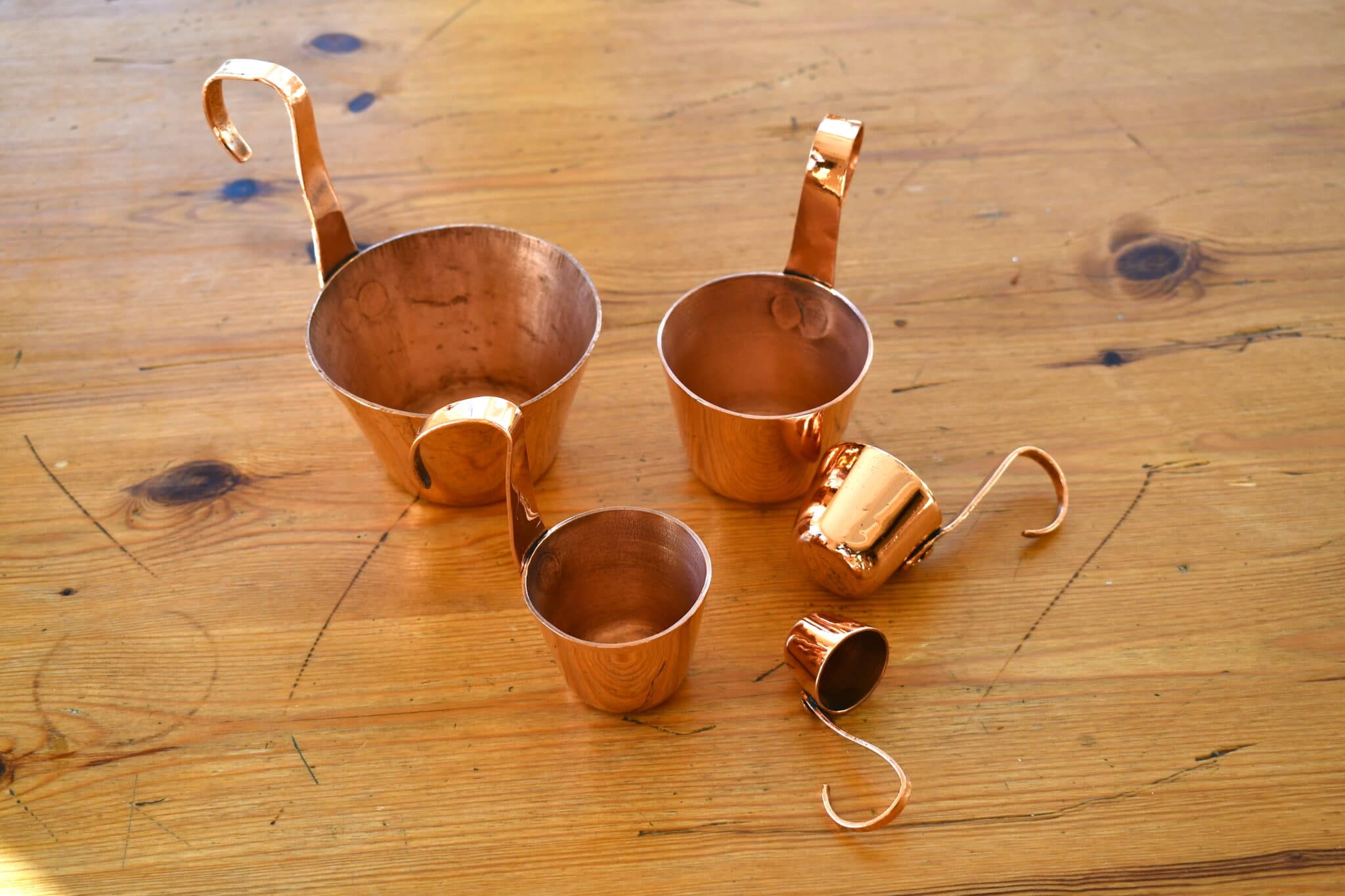A side-by-side comparison of pre-war and post-war Jacquotot construction.

| Type | Two tin-lined sauté pans with iron handles attached with three copper rivets | |
| French description | Deux sauteuses étamées et martelées avec queue de fer munie de trois rivets en cuivre | |
| Dimensions | 22cm diameter by 7cm tall (8.7 inches by 2.8 inches) |
22cm diameter by 6.5cm tall (8.7 inches by 2.6 inches) |
| Thickness | 1.8mm at rim | 2.7mm at rim |
| Weight | 1930g (4.25 lbs) |
2320g (5.11 lbs) |
| Stampings | J. Jacquotot, 128 & 130 R. de Grenelle, Paris; 22; M∗R; 2 on pan body |
J. Jacquotot, 77 Rue Damesme, Paris; Made in France; CONTI |
| Maker and age estimate | Jacquotot, 1922-1930s? | Jacquotot, 1950s-1990s? |
| Owner | Stephen Whalen | |
What’s lovely about these pans — and why I’m so grateful to Stephen Whalen for sharing them with us — is that they give us the opportunity to see how Jacquotot craftsmanship changed from the 1930s to the post-WWII era.
Let’s start with the stamps.


The pan on the left has the 128 & 130 Rue de Grenelle stamp, which was the firm’s address from 1922 to at least 1938 and possibly later, but I can’t find any commercial records after that date. The pan on the right has the stamp with the 77 Rue Damesme address to which the firm relocated at some point — possibly around 1955, when founder Jean-Baptiste Jacquotot passed away and his son Alfred took over, but certainly by the 1960s. The “Made in France” stamp dates this pan to post-1957; the stamp itself is a cypher. It’s the same “long M” design I’ve seen on pieces stamped for Gaillard and was possibly also used by Mauviel. This suggests but does not establish that Gaillard, Jacquotot, and Mauviel shared production capacity during this period, and is a mystery I have yet to unravel.
Based on these stamps, I believe we can look at these pans as pre-war (that is, 1922 to 1930s) and post-war (1950s and later).
(Note that I think there is a stamp that falls between these two in the timeline: a three-line text-only stamp with the 128 & 130 Rue de Grenelle address. You can see it in the field guide. It’s the missing link between the stamps on these pans — it has the “old” address but in the “new” design. For this reason, I think the oval Rue de Grenelle stamp above is on the early end of the 1922-1938-ish range; the company redesigned the stamp to the more modern text-only design at some point and kept that design after the move to Rue Damesme.)
Side-by-side, they don’t look very different, aside from a slight difference of proportion. (In these comparison photos, I’ll put the earlier pan on the left and the later pan on the right.) They are both 22cm diameter but note that the earlier pan on the left is 7cm tall, .5cm taller than the pan in the right at 6.5cm tall.


The handles are also quite similar. To my eye the center rivet on the early pan’s handle is placed slightly lower than that on the later pan; I suspect this placement is up to the position of the pre-drilled (or perhaps pre-cast?) holes in the handle. But more importantly to me, the metal of the handles looks identical — the same silvery sheen, perhaps a nickeled finish or the same cast iron alloy. I doubt Jacquotot was casting its own iron handles at this point, any more than it was forging its own sheet metal — instead they’d be buying from a specialized supplier who likely also supplied other French makers. (This may be another reason why handles all look so similar!)


I can’t make up my mind whether or not the rivet diameter has changed. Rivets in this modern era are shaped like mushrooms, with the bulbous cap end on the inside and the blunt shaft end poking out of the handle holes. The riveting process clamps the mushroom head tight against the pan and handle and then heats and compresses the blunt end, forcing the rivet to expand to fill the drilled hole and reshaping the end into a flattened or rounded cap. The flattened end we see on the outside is larger in diameter than the rivet shaft, but the question is, how much larger? Different construction methods produce different finished shapes, and I don’t know enough to say whether the rivets are different sizes.
Let’s take a look at the interior rivet treatments.




As above, I can’t say whether the rivet shafts are different diameters, but it’s clear that the rivets themselves came from different suppliers: the mushroom head on the early pan’s rivets is clearly smaller and lower profile than the larger, more protuberant heads on the newer rivets. Note that the early pan’s rivets have the ghostly remnants of numbers on them — a sign of 20th-century construction, referring to the diameter in millimeters of mass-produced rivets. The later pan on the right does not show numbers but they could have been obliterated during the insertion or later hammer blows to tighten them.
So far I’ve seen relatively minor differences between the two pans, but there is one major difference: the beveling around the base.

The early pan on the left has two beveled planes running around the perimeter of the base, whereas the pan on the right, the later pan, has a smooth curve. Bevels were added to the pan after it was pressed into shape in order to work-harden the copper in this vulnerable area and render it more resistant to dents and damage. Sauté pans are designed for “jumping” — sliding the pan along the cooktop or even lifting and flicking it in the air to toss food — and so these edge bevels are a welcome sight.
However, adding bevels is an extra manufacturing step. Each plane must be laid down by hand-hammering, and I don’t see bevels on modern-era pans. Perhaps the manufacturers realized that by the 1950s and 1960s restaurants were shifting to stainless steel or aluminum cookware, and there was no longer a significant demand for extra-resilient copper cookware; perhaps the additional manufacturing steps added too much to the cost of goods sold. Whatever the reason, I have only seen beveled edges on pans that, based on their stamps, construction, and condition, look to be late 19th or early 20th century pans, just like the early Jacquotot under examination here.
In sum, this is what these pans suggest to me about Jacquotot production over the 20th century:
They shortened their 22cm sauté pans, and possibly others as well. The half-centimeter difference in height does not seem like a major difference but it was intentional: it would have entailed changing the die to cut the copper sheet and possibly retooling the press. A shorter pan would save some weight and also reduce the cost of goods sold.
They maintained the same style of cast iron handles. The handle baseplates and hanging loops look to be of identical shape and the metal has a very similar if not identical color and sheen. The rivet holes have a slight difference in alignment but that could have been due to a new mold or drilling pattern.
They changed rivets. As above, I don’t know if the rivet diameters changed, but the size and shape of the mushroom head end of the rivets are obviously different between the two pans.
They added bevels in early production, but ceased the practice. The early pan has two planes of beveling while the later pan does not show this extra hand-finishing. (You can see more examples in this early beveled Jacquotot saucepan and this later non-beveled sauté.)
I’m not yet sure if these observations amount to actual clues as to what happened to Jacquotot after World War II. My hunch is that the devastation of the war triggered a collapse and consolidation of the French chaudronneries; I suspect many small family firms simply closed up shop. But Jacquotot, Mauviel, Gaillard, and others survived — my guess is, in part, by jettisoning time-intensive finishing work to cut costs, or even outsourcing production to machine shops such as Multiform in Villedieu. At the moment I’m trying to learn more about the Jacquotot facility at 77 Rue Damesme after the war, what pieces they made, and for how long they kept producing them. Any information you may be able to share about this history would be most welcome.
But these pans are not just exemplars of Jacquotot production during two different periods of its history — each has its own story to tell.
The early Jacquotot pan has survived with its original lid, as attested by matching maker and owner stamps. The pan body and lid are both marked “M∗R”; Stephen Whalen relays that the seller believed the initials stood for “Moulin Rouge,” the famous cabaret and restaurant in Paris. This would be a fabulous provenance indeed!




The later pan carries the owner stamp “CONTI.” Stephen says is for the Restaurant Conti in Paris, an Italian restaurant with a lavish red and black interior that evokes a Venetian theater.


These are beautiful and rare pans and I’d like to thank Stephen for sharing them with us. Jacquotot remains intriguing to me — my field guide goes through the history as I have been able to document it, but there is still much to be learned. It’s a pleasure to see these pieces close up and examine their similarities and differences — and to imagine their experiences over the decades.






Hi,
these are beautiful, I have have a slightly earlier 22cm saute maker unknown with an address on the Rue Pigalle, which pleases me immensely given the reputation that area had.
I find that beveled edges are often an indication of a thicker base, 1.8mm is ok for walls but not ideal for the base so I wonder if that is the case here. If I am correct then the extra height may be to put a little more weight above the handle so keeping the pan feeling balanced which is important in a saute.